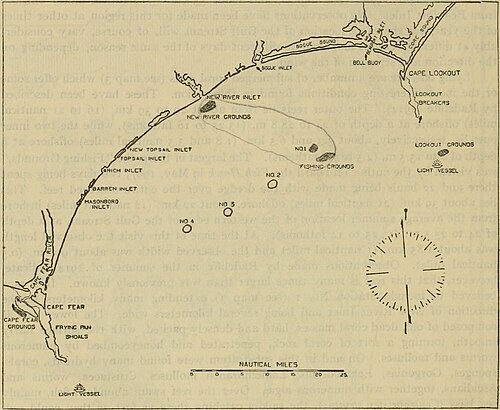Bogue Banks

Bogue Banks form a 21-mile (34 km)
History
This section has multiple issues. Please help improve it or discuss these issues on the talk page. (Learn how and when to remove these template messages)
|
During a survey titled "The Greater Beaufort Area at 1800" completed by the North Carolina State College, or present-day
Salter Path
The decline in the
John Royall built a house on the island known as Pine Court. Royall was a conservationist and steward to the natural beauty of the island In addition to the main house, Royall built a physician’s cottage (later renovated and leased to Alice Green Hoffman) and a Tea House on the ocean side of the island now a popular look-out.
In 1923, John A. Royall sold 2,000 acres of his property to Alice Green Hoffman, a distant relative of
Points of interest
The Emerald Isle
Communities
The island is located in Morehead Township and White Oak Township. The following are communities on Bogue Banks:
Surrounding waters
- Onslow Bay (Atlantic Ocean) - south
- Bogue Sound (Intracoastal Waterway) - north
- Bogue Inlet - west
- Beaufort Inlet - east
- White Oak River - northwest
- Newport River - northeast
Bogue Inlet Fishing Pier
The Bogue Inlet Fishing Pier, located on the western end of the Bogue Banks is one of the only fishing piers left on the island. In 2006, a beachfront development company applied to purchase the pier's land for the construction of
to stop demolition of the pier.References
- ^ Orrin H. Pilkey, The North Carolina Shore and its Barrier Islands: restless ribbons of sand 1998:161
- ^ "Carteret County Shore Protection Office - WWW . PROTECT THE BEACH . COM". Archived from the original on 2007-09-28. Retrieved 2007-08-16.
- ^ David S. Cecelski, A Historian's Coast: adventures into the Tidewater past, "Elliott Coues, a naturalist at Fort Macon", 2000:49ff; Coues' unique faunal catalogue, "Notes on the natural history of Fort Macon, N.C. and vicinity", in five sections, was published in the Proceedings of the Academy of Natural Sciences of Philadelphia.
- ^ David M. Bush, Orrin H. Pilkey and William J. Neal, Living by the Rules of the Sea 1996:151.
- ^ "OV Bogue Banks2 - Bogue Banks including Atlantic Beach, Pine Knoll Shores and Indian Beach Area Overviews | NC's Central Coast | Insiders' Guide". Archived from the original on 2007-09-27. Retrieved 2007-08-16.
- ^ newsobserver.com |At the Beach - Emerald Isle wants to save Bogue Inlet pier Archived November 17, 2006, at the Wayback Machine
